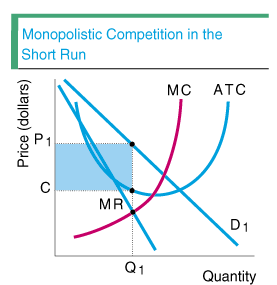Chapter 13
 In the short run, as the only
restaurant in the area, the firm can earn an economic profit.
But, as time passes, more restaurants will open up. As they
do so, they decrease the demand for the first firm's meals.
We can see this reduction in demand occurring in the figure,
in which the demand curve for the restaurant's meals
decreases as new firms open.
In the short run, as the only
restaurant in the area, the firm can earn an economic profit.
But, as time passes, more restaurants will open up. As they
do so, they decrease the demand for the first firm's meals.
We can see this reduction in demand occurring in the figure,
in which the demand curve for the restaurant's meals
decreases as new firms open.
Note that as the demand curve shifts leftward, the
restaurant's economic profit, equal to the light blue area,
decreases. However, as long as there is the potential for an
economic profit, new restaurants will open. Thus as long as
the firm has any economic profit, new firms will enter
the market trying to earn some of the economic profit, the
demand curve will shift leftward, and the economic profit
will shrink.
Eventually, enough new firms enter the market so that all
the economic profit is competed away. At this point, new
firms no longer have an incentive to enter the market; that
is, the promise of an above average profit has evaporated.
Hence, at this time new restaurants no longer open around
campus and so we have reached the long-run equilibrium.
The figure shows the long-run equilibrium for a
monopolistically competitive firm. In the long run, the
restaurant produces where its new marginal revenue curve
crosses its marginal cost curve, MC. Thus the firm
produces Q2 meals and charges a price of P2
for a meal. The price the restaurant charges for its meals
just equals its average total cost of producing the meals, so
the restaurant earns only a normal profit. In other words,
the restaurant earns an average profit rather than an
extraordinarily high economic profit.